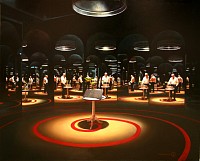BIOGRAPHY

JAMES MOONEY
(b. 1944, England)
Born in February 1944 in Kidderminster, England, Mooney left school at the age of fifteen to serve his electrical apprenticeship.
In 1966, he and his family emigrated to South Africa where he started various businesses in Cape Town and travelled the world, settling in Australia for two years in the early seventies, then in England, before returning to South Africa in the early eighties. His wife Jill is also an artist and they have lived in the Southern Cape since 1983.
Mooney began painting in 1972 and exhibited at various local exhibitions until his first one-man exhibition “Beyond Reason” at the “1820 Monument” in Grahamstown in 1991. His “Portrait of James Joyce” was chosen for the 1991 Cape Town Triennial and purchased by the King George VI Gallery in Port Elizabeth.
Over the last 20 years there have been fifteen composite “Portraits”, the earlier of which were of cultural heroes and villains including Thomas Mann, Oscar Wilde, Marilyn Monroe, James Joyce and Archduke Ferdinand’s assassin (who precipitated the first World War). Latterly he has focused on self-portraits since, as Mooney says, “…the other portraits ended up being history as filtered by my perception, and hence all auto-biographical anyway”. These contain between two and five hundred miniatures including many genres ranging from realism to abstract expressionism. They reflect his recurring obsession with history and memory as well as his frustration with infinite ideas and finite time. Mooney has a sense of being at the centre of multiple streams of stylistic expression (abstract, surreal, historical, representational and various hybrids of the same) each of which somehow satisfy a part of him and yet if he delves into any one stream exclusively, as most painters do, he could spend a lifetime trying to perfect that to the exclusion of the others. The portraits in some way appease his anxiety over "so much to do in so little time” and at the same time reflect the complexity of Mooney´s (and of course our own) psychological world. One could perhaps not ask for a more honest portrait.
Mooney includes in these portraits a technique that he has developed and named "vibrato". Most of the monochromatic miniatures employ this technique, whereby marks applied apparently haphazardly congeal into mysteriously evocative imagery; a few monochromatic marks soon vibrate to evoke a vast medieval army on horseback, battle lines drawn, ready to descend on an absent enemy. These in some way mirror the whole optical illusion of the portrait.
In addition to these large portraits, Mooney is well known for his small works depicting nymphs frolicking in the woods, inspired by the forests of Knysna. This period, however, made way for tougher, more urban figurative works which are often highly erotic and enigmatic. Mooney’s main interest here is evoking tension and dialogue between his subjects without any particular narrative, leaving room for us, the witness, to fill in the gaps.
He is also a writer of poetry and short stories, none of which have been published, and he is interested in all the sciences, in particular astrology.
Mooney is a somewhat secretive individual who eschews the limelight. As a consequence he has declined solo exhibitions over the years (also a factor of the exacting and slow nature of the type of work he does). The one exception to this was his Retrospective exhibition, “….a Grain of Sand” in 2005 at Everard Read Cape Town.
“The miniatures of course grew in size as a natural consequence of becoming familiar and therefore losing their challenge. Pursuit of fascination knows no bounds. I had to experiment with new techniques to allow for increase, as what may appear convincing in miniature does not always do so through simple expansion, as any experience will teach. Fortunately many of the earlier textural discoveries that seemed isolated at the time became of use. This was both exciting and rewarding.
The freedom of working small and unrestrained by time must be compensated by the lure of accomplishment of things beyond one for the moment. Failure is an inevitable property of experimentation but as I have never had any goals in my paintings except to indulge my fascination these failures usually yield some benefit-even if to avoid the same thing in the future. What they never fail to do however, whether successful or not in execution, is to hold me spell bound during that period. Success by this measure is never in doubt.
The more I learn of the business the more I realized that very little of what I have discovered is new; I have just put together known things in a slightly different way.”



